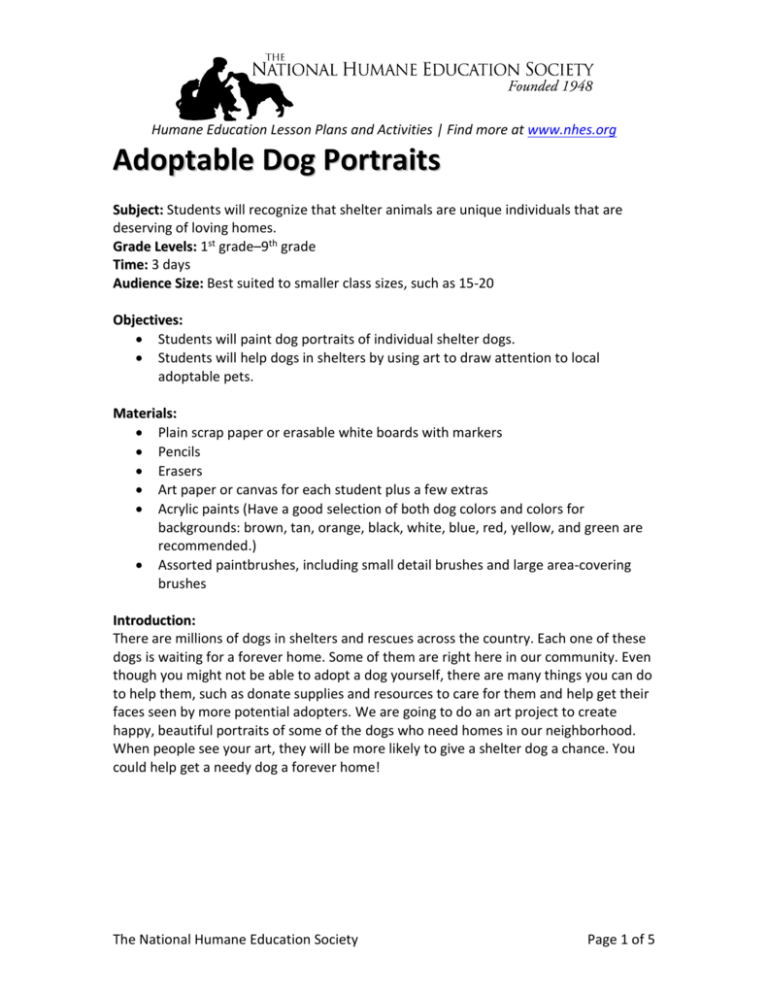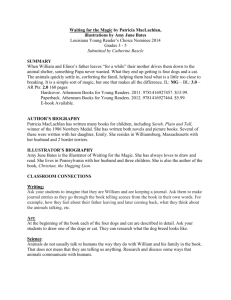Microsoft Word - Briggs Animal Adoption Center
advertisement

Humane Education Lesson Plans and Activities | Find more at www.nhes.org Adoptable Dog Portraits Subject: Students will recognize that shelter animals are unique individuals that are deserving of loving homes. Grade Levels: 1st grade–9th grade Time: 3 days Audience Size: Best suited to smaller class sizes, such as 15-20 Objectives: Students will paint dog portraits of individual shelter dogs. Students will help dogs in shelters by using art to draw attention to local adoptable pets. Materials: Plain scrap paper or erasable white boards with markers Pencils Erasers Art paper or canvas for each student plus a few extras Acrylic paints (Have a good selection of both dog colors and colors for backgrounds: brown, tan, orange, black, white, blue, red, yellow, and green are recommended.) Assorted paintbrushes, including small detail brushes and large area-covering brushes Introduction: There are millions of dogs in shelters and rescues across the country. Each one of these dogs is waiting for a forever home. Some of them are right here in our community. Even though you might not be able to adopt a dog yourself, there are many things you can do to help them, such as donate supplies and resources to care for them and help get their faces seen by more potential adopters. We are going to do an art project to create happy, beautiful portraits of some of the dogs who need homes in our neighborhood. When people see your art, they will be more likely to give a shelter dog a chance. You could help get a needy dog a forever home! The National Humane Education Society Page 1 of 5 Procedure: Preparation before Day 1: 1. Select dogs from a local shelter for your class. Your students will need the dog’s name and a photo to use as a reference. It will also help the student connect to the animal if you can get a short description for each one. Much of this information can be found by looking up your local shelter’s website or looking on an adoption website such as Petfinder.com. Give the shelter notice of your project. They will likely be happy to help with pictures and information. 2. You will need to select a destination for this artwork. You may choose to give it to the shelter housing the dogs. You could also hang it in a community area where future adopters may see it, such as a shopping center, your school’s office area, or another place that families are likely to frequent. 3. Familiarize yourself with simple steps on how to draw a dog. We have provided you with two step-by-step guides with descriptions to help you and your students understand. You can also look up guides on the Internet or in drawing books. Dog #1 (very simple, for use with younger students) 1. Begin with a stick figure without arms. Be sure to leave room above the stick figure on your paper. 2. Draw a close circle around the stick figure. Place three dots on each side. 3. Place two eyes above the circle. Fill in two black pupils. 4. Draw another circle around everything you have drawn so far. Try to make the bottom of this circle overlap with your last circle. 5. Draw ears on each side of your large circle. The National Humane Education Society Page 2 of 5 Dog #2 (more complex, for use with students who have moved beyond basic shapes) 1. Begin with a circle in the middle of your paper. 2. Draw a wide, rounded U shape sticking out of your circle for a snout. Erase the lines of your circle that overlap. 3. Draw a round, wide, upside-down triangle for the nose and two curved lines for the mouth. 4. Half-way down the circle, draw two eyes. You do not want to draw them too high on the head. 5. Add the ears. Many dogs will have floppy ears that can be drawn with rounded upside-down triangles like this. Make sure that the triangle is placed half on, half off the circle. Erase where the circle overlaps the ear triangle. a. Another ear shape could be upright ears. These are simply upright, curved triangles. The base of the triangle should start just above the eyes on the sides of the circle. The National Humane Education Society Page 3 of 5 b. Another ear shape could be droopy ears. These are the easiest to draw. Draw a long line from the side of the circle, then loop back up to meet the circle just above the “U” for the snout. 6. Draw a neck off your circle. For ours, we drew it slightly to the side. Then, erase the part of the original circle that is within the neck area. We also straightened the area below the left ear to meet the neck line more smoothly. Day 1 – Practice Drawing – About 45 minutes: 1. Using a step-by-step guide, show your class how to draw a dog. Demonstrate the shapes on a large board or with an overhead projector. You may want to print out the procedure you choose and pass it out to the class. 2. Pass out drawing materials to your class. Easily erasable white boards are a great way to let younger children practice their drawings. You can also use scrap paper. 3. Erase your original drawing or use the empty space next to it, and draw your dog step by step again. This time, have the students draw their dogs with you. Answer any questions they might have as you go. If you are using our dog sample, be sure to draw the different types of ears. 4. Pass out your reference photos and dog information to the students. Each student should get one dog’s photo and information. Ask them to write their names on the back on the photos and information sheets. 5. Talk to the students about differences in their dogs and the practice dogs. All dogs are individuals though, and they might have to make changes to their practice drawing to make it match their adoptable animal. Your students will also want to find a way to work the dog’s name into the picture. 6. Allow the students to spend time practicing their drawings on white boards or scrap paper. Ask students to write their names on the whiteboards or scrap papers. 7. Collect reference photos and drawing drafts to pass out on Day 2. Day 2 – Final Draft of Drawing – About 30 minutes: 1. Pass each student’s papers from Day 1 and allow them some time to continue working on drafts. 2. When they are ready, pass out the canvases or art paper for their final drafts. Instruct your students to use their pencils very lightly when drawing their final The National Humane Education Society Page 4 of 5 drafts; this way they can easily erase if they make a mistake. Also, lightly drawn pencil marks are much easier to hide with paint. 3. As your students are drawing their dogs, tell them to start thinking about what background colors would complement their dog. Remind them that a black animal won’t stand out well against a dark background and a brown animal might blend into a red background. 4. Collect the final drafts to pass out on Day 3. Day 3 – Painting – About 45 minutes: 1. If you are teaching younger students, you should have each student’s work station set up before he or she arrives. Older students can set up their own areas. Each work station will need: at least one paper towel for wiping brushes, a cup of water (this can be shared among students who sit close together), varying sizes of paintbrushes (these can be shared among students who sit close together), a paint palette with wells for different colors, and a flat palette or a plate for mixing colors. 2. Pass each student’s papers from Day 2. Because the students are seeing their drawings with a fresh eye, they may want to make alterations before painting. 3. If you are teaching younger students, use the time when they are editing their drawing to start filling paint wells; older students can fill their own paint wells. Use your judgment based on their reference photos as to which colors they will need for the dog. Each palette will probably need black (for shading and pupils), white (for tinting and highlighting), brown (for brown eyes), and red (for making pinks that many dogs have in their ears or mouths). Allow students to choose a color for their background that will complement their animal. 4. Walk around and give compliments and helpful advice to students as they paint. Young students who do not fill their own paint wells will often need refills as they paint. 5. As students finish, place the portraits in a safe place to dry. Summary: After the portraits are completed and dried, take a photo of each piece of artwork. After hanging, you may not be able to get the originals back (some animal shelters may want to keep them to decorate their own walls, or even send the art home with adopters), so these photos can be kept by the students. If your situation allows, a short field trip to the animal shelter could be planned for the presentation of the portraits. If not, try to get pictures of the location where the portraits are hung to share with the class. The National Humane Education Society Page 5 of 5





